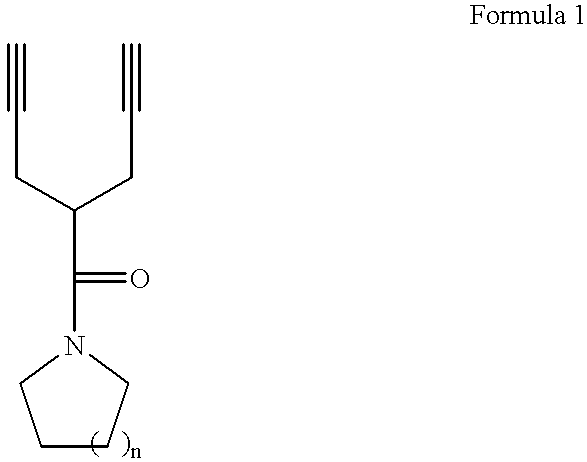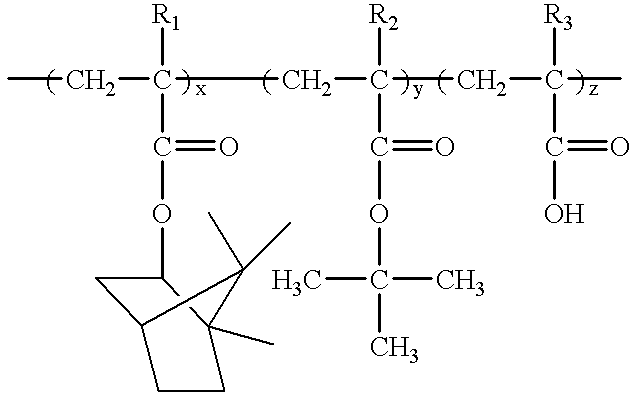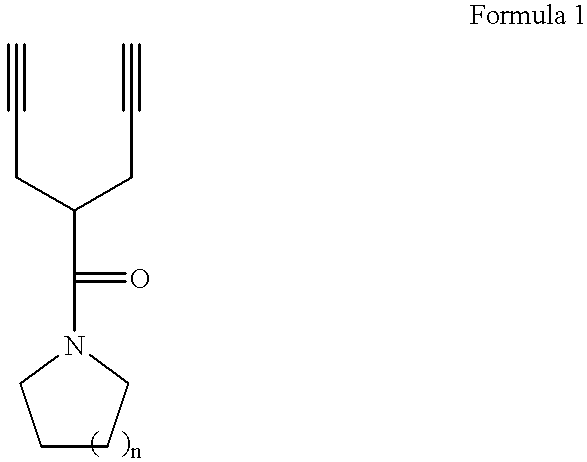Photoresist monomers, polymers thereof, and photoresist compositions containing the same
a technology of photoresist monomers and polymers, which is applied in the field of photoresist monomers, polymers thereof, and photoresist compositions containing the same, can solve the problems of difficult synthesizing a photoresist polymer that satisfies all of these criteria, thin pattern collapse, and loss of photoresist top, etc., to achieve the effect of improving ped stability
- Summary
- Abstract
- Description
- Claims
- Application Information
AI Technical Summary
Benefits of technology
Problems solved by technology
Method used
Image
Examples
example 1
Synthesis of Piperidinyl Dipropargyl Acetamide
24.9 g of acetylpiperedine was slowly added into a solution obtained by dissolving 7.8 g of sodium in 150 ml of ethanol at 0.degree. C. The resulting solution was stirred for one hour, and 48 g of propargyl bromide was slowly added thereto. Thereafter, the resulting solution was refluxed for one hour, and ethanol was removed under reduced pressure. The residual solution was diluted using distilled water, and an organic layer was separated. The resulting solution was re-crystallized in hexane, to obtain 32 g of title compound of Formula 1a (yield: 80%).
example 2
Synthesis of Pyrrolidinyl Dipropargyl Acetamide
22.0 g of acetyl pyrrolidine was slowly added into a solution obtained by dissolving 7.8 g of sodium in 150 ml of ethanol at 0.degree. C. The resulting solution was stirred for one hour, and 48 g of propargyl bromide was slowly added thereto. Thereafter, the resulting solution was refluxed for one hour, and ethanol was removed under reduced pressure. The residual solution was diluted using distilled water, and an organic layer was separated. The resulting solution was re-crystallized in hexane, to obtain 26.7 g of title compound of Formula 1b (yield: 75%).
II. Preparation of Photoresist Polymer
example 3
Synthesis of Poly(Tert-butyl Dipropargyl Acetate / Dipropargyl Carbinol / Piperidinyl Dipropargyl Acetamide)
To a 100-ml-flask was added 10 ml of 1,4-dioxane and 5 mM of MoCl.sub.5 solution. After 15 minutes at 30.degree. C. under nitrogen atmosphere, 24.03 g of tert-butyl dipropargyl acetate, 13.52 g of dipropargyl carbinol and 1.3 g of piperidinyl dipropargyl acetamide were slowly added and polymerized at 60.degree. C. for 24 hours. The polymerization reaction was stopped by adding a small amount of methanol. The resultant polymer was dissolved in chloroform and precipitated in methanol. The precipitate was filtered and dried under reduced pressure, to obtain 31.1 g of title polymer of Formula 4 (yield: 80%).
PUM
 Login to View More
Login to View More Abstract
Description
Claims
Application Information
 Login to View More
Login to View More - R&D
- Intellectual Property
- Life Sciences
- Materials
- Tech Scout
- Unparalleled Data Quality
- Higher Quality Content
- 60% Fewer Hallucinations
Browse by: Latest US Patents, China's latest patents, Technical Efficacy Thesaurus, Application Domain, Technology Topic, Popular Technical Reports.
© 2025 PatSnap. All rights reserved.Legal|Privacy policy|Modern Slavery Act Transparency Statement|Sitemap|About US| Contact US: help@patsnap.com



